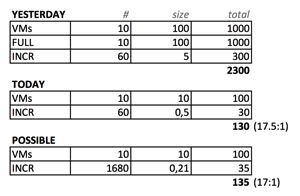Yet another rant that will get me in even more trouble than I was before, trying to find a role in technical marketing. This time I want to show you some of the tricks marketing uses that are in my book an insult to the intelligence of the customer. The first thing I would like tot tackle are the SAVINGS.
The Savings
Yesterday there was an online discussion about space savings. Something in the line of “look a this screenshot that proves you we have 700:1 space savings”. The problem you have here is that we are using the current results to prove a historical difference. Let me elaborate with a practical example.
- Yesterday: I had 10 VMs of 100GB each (1TB total). They all change 5GB of unique data per day. I am doing a full backup in the weekend and 1 incremental a day which results in 1.3TB of backup storage. I now have a total of 2.3 TB of storage.
- Today: I just installed this flashy new technology that does thin provisioning, compression and deduplication. Now I get an average of 10:1 data reduction on my production storage which results in having only 100GB of production data. As I have deduplication built-in I don't really need a full backup anymore as it is pointing to the same blocks. I will however need those 5GB of unique data and for the sake of the example let’s use that same 10:1 data reduction. So now we end up with 100Gb of production and 35GB of backup data, which is a total of 17.5:1 reduction to the original 2.3TB.
- Tomorrow: because I don’t have to take full backups and taking an increment has little to no impact we can take a recovery point every hour. This gives 24 recovery points a day but there is not really more data change so we have 5GB/24 data per point extra but we do have 7*24 data recovery points. Now how does this look for savings? The exact SAME.

What marketing will want you to believe is that you did savings on 1680 x 100GB VM or 168TB of used storage. This is not true as you were not spending it in the first place! If you had no need for more than 1 recovery point per day this is not saving you anything more.
My Take
SAVINGS is what you would not pay what you are paying TODAY! That being said there could be extra advantages by using new technology in other ways for example by lowering the cost of RPO/RTO.
Next time I want to talk about why “Dollar per Metric” is a fallacy as well.

Hans,
I like the premise of the post, however there are a few considersations that weren’t mentioned, which I’d like to mention now.
1. Lots of customers have constraints. Sometimes the 1 recovery point per day isn’t their requirement, but all the budget allows for. Showing the potential for a shorter RPO valid
2. Customers looking a new storage solutions typically don’t look at what they are doing today. Customers are looking at the next 36-72 months (depending on refresh cycle). The future may hold different requirements then what is currently being practiced in their environment today.
There is nothing wrong with showing the potential of a product. However, I do agree with you that using that potential as a selling/marketing tool for a customer that has no use for it is insulting.
-Josh
You hit exactly what I was trying to say; ‘showing the potential for a shorter RPO‘ is an additional benefit or sales argument but it doesn’t add up as a SAVINGS metric. Your second point into looking to the future is exactly what I will hit on in part 2: the ‘Dollar per Unit‘ fallacy!
[…] In Part 1, I pointed at the use of the word SAVINGS in Marketing where using new technology to their extremes would save you money. The fallacy I pointed out there is that you actually would pay less than today but that the numbers used by Marketing point at future which you are not paying for today so would not be savings. […]
[…] Part 1 I discussed the (ab)use of SAVINGS. In Part 2 the focus went to DOLLAR per UNIT. In this third, and […]
[…] Fooled by Marketing Metrics – Part 1 – The Savings Fallacy […]
[…] by marketing metrics This was an interesting read. I loved working in Technical Marketing. It was marketing that was truthful and technical and […]